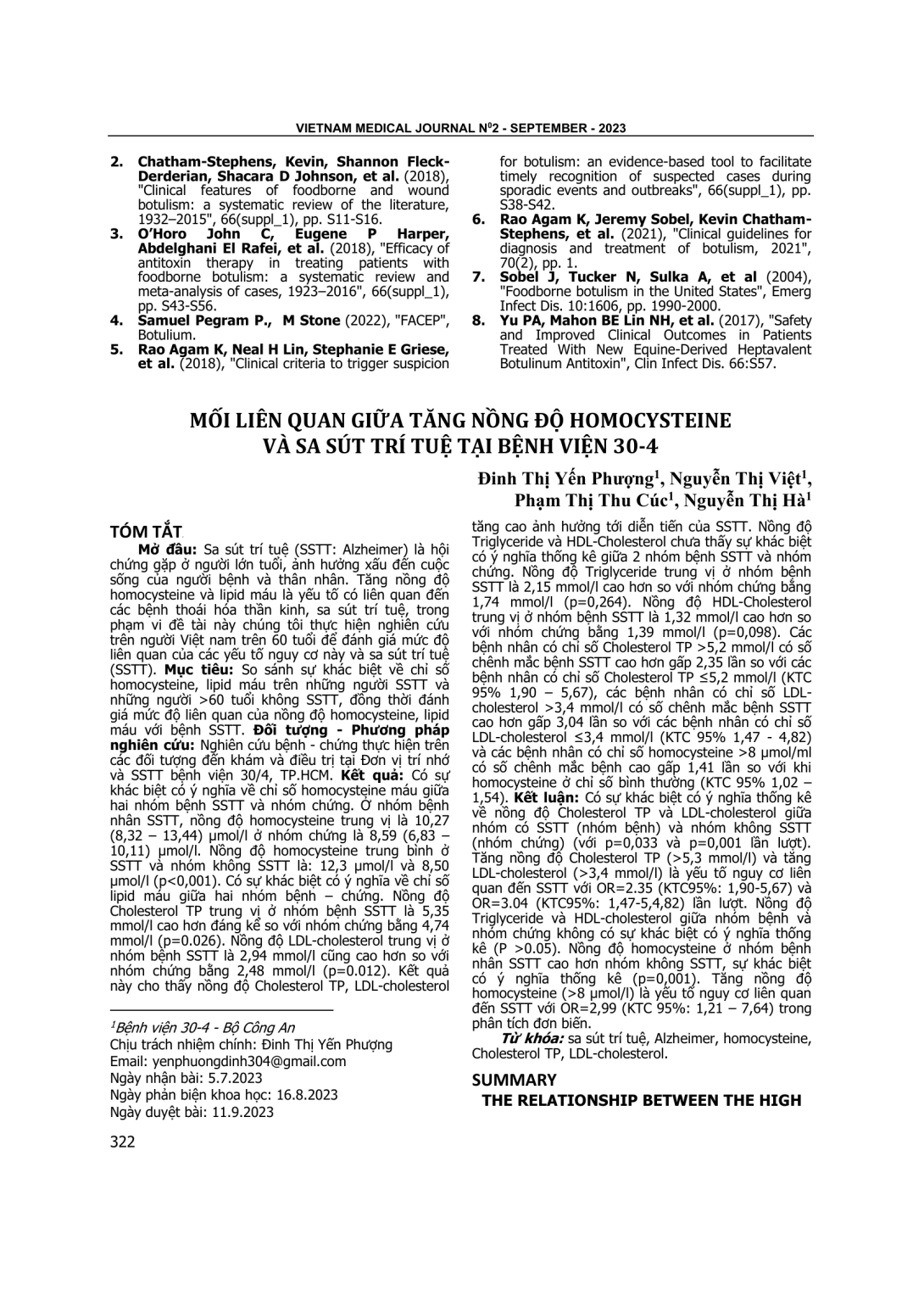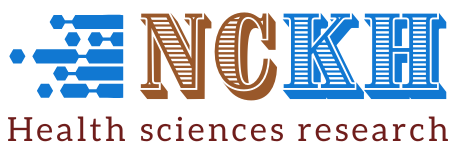
Sa sút trí tuệ (SSTT: Alzheimer) là hội chứng gặp ở người lớn tuổi, ảnh hưởng xấu đến cuộc sống của người bệnh và thân nhân. Tăng nồng độ homocysteine và lipid máu là yếu tố có liên quan đến các bệnh thoái hóa thần kinh, sa sút trí tuệ, trong phạm vi đề tài này chúng tôi thực hiện nghiên cứu trên người Việt nam trên 60 tuổi để đánh giá mức độ liên quan của các yếu tố nguy cơ này và sa sút trí tuệ (SSTT). Mục tiêu: So sánh sự khác biệt về chỉ số homocysteine, lipid máu trên những người SSTT và những người >60 tuổi không SSTT, đồng thời đánh giá mức độ liên quan của nồng độ homocysteine, lipid máu với bệnh SSTT. Đối tượng - Phương pháp nghiên cứu: Nghiên cứu bệnh - chứng thực hiện trên các đối tượng đến khám và điều trị tại Đơn vị trí nhớ và SSTT bệnh viện 30/4, TP.HCM. Kết quả: Có sự khác biệt có ý nghĩa về chỉ số homocysteine máu giữa hai nhóm bệnh SSTT và nhóm chứng. Ở nhóm bệnh nhân SSTT, nồng độ homocysteine trung vị là 10,27 (8,32 – 13,44) μmol/l ở nhóm chứng là 8,59 (6,83 – 10,11) μmol/l. Nồng độ homocysteine trung bình ở SSTT và nhóm không SSTT là: 12,3 μmol/l và 8,50 μmol/l (p<0,001). Có sự khác biệt có ý nghĩa về chỉ số lipid máu giữa hai nhóm bệnh – chứng. Nồng độ Cholesterol TP trung vị ở nhóm bệnh SSTT là 5,35 mmol/l cao hơn đáng kể so với nhóm chứng bằng 4,74 mmol/l (p=0.026). Nồng độ LDL-cholesterol trung vị ở nhóm bệnh SSTT là 2,94 mmol/l cũng cao hơn so với nhóm chứng bằng 2,48 mmol/l (p=0.012). Kết quả này cho thấy nồng độ Cholesterol TP, LDL-cholesterol tăng cao ảnh hưởng tới diễn tiến của SSTT. Nồng độ Triglyceride và HDL-Cholesterol chưa thấy sự khác biệt có ý nghĩa thống kê giữa 2 nhóm bệnh SSTT và nhóm chứng. Nồng độ Triglyceride trung vị ở nhóm bệnh SSTT là 2,15 mmol/l cao hơn so với nhóm chứng bằng 1,74 mmol/l (p=0,264). Nồng độ HDL-Cholesterol trung vị ở nhóm bệnh SSTT là 1,32 mmol/l cao hơn so với nhóm chứng bằng 1,39 mmol/l (p=0,098). Các bệnh nhân có chỉ số Cholesterol TP >5,2 mmol/l có số chênh mắc bệnh SSTT cao hơn gấp 2,35 lần so với các bệnh nhân có chỉ số Cholesterol TP ≤5,2 mmol/l (KTC 95% 1,90 – 5,67), các bệnh nhân có chỉ số LDL-cholesterol >3,4 mmol/l có số chênh mắc bệnh SSTT cao hơn gấp 3,04 lần so với các bệnh nhân có chỉ số LDL-cholesterol ≤3,4 mmol/l (KTC 95% 1,47 - 4,82) và các bệnh nhân có chỉ số homocysteine >8 μmol/ml có số chênh mắc bệnh cao gấp 1,41 lần so với khi homocysteine ở chỉ số bình thường (KTC 95% 1,02 – 1,54). Kết luận: Có sự khác biệt có ý nghĩa thống kê về nồng độ Cholesterol TP và LDL-cholesterol giữa nhóm có SSTT (nhóm bệnh) và nhóm không SSTT (nhóm chứng) (với p=0,033 và p=0,001 lần lượt). Tăng nồng độ Cholesterol TP (>5,3 mmol/l) và tăng LDL-cholesterol (>3,4 mmol/l) là yếu tố nguy cơ liên quan đến SSTT với OR=2.35 (KTC95%: 1,90-5,67) và OR=3.04 (KTC95%: 1,47-5,4,82) lần lượt. Nồng độ Triglyceride và HDL-cholesterol giữa nhóm bệnh và nhóm chứng không có sự khác biệt có ý nghĩa thống kê (P >0.05). Nồng độ homocysteine ở nhóm bệnh nhân SSTT cao hơn nhóm không SSTT, sự khác biệt có ý nghĩa thống kê (p=0,001). Tăng nồng độ homocysteine (>8 μmol/l) là yếu tố nguy cơ liên quan đến SSTT với OR=2,99 (KTC 95%: 1,21 – 7,64) trong phân tích đơn biến.
Dementia is a common syndrome in the elderly, affecting quality life of patients and family caregivers. High level of blood homocysteine and anemia are considered factors that can be used to assess of neurodegenerative diseases. We therefore want to research in Vietnam to find the relevance of these risk factors for Alzheimer's disease in Vietnamese elderly (>60 years old). Objectives: To compare the differences in level of blood homocysteine and lipid indices between people with dementia and those non-dementia, then to measure their association with dementia. Method: A case-control study was conducted on the subjects who are diagnosed dementia at the Memory Dementia Unit in 30/4 Hospital, Ho Chi Minh city. Results: There was a significant difference in blood homocysteine index between the two groups of dementia and those without dementia. In the group of patients with dementia, the median homocysteine concentration was 10.27 (8.32 – 13.44) μmol/l, in the control group was 8.59 (6.83 – 10.11) μmol/l. The average homocysteine concentrations in dementia and non-dementia groups were: 12.3 μmol/l and 8.50 μmol/l (p<0.001). There was a significant difference in blood lipid index between the two groups of dementia – the group without dementia. The median total cholesterol concentration in the dementia group was 5.35 mmol/l which was significantly higher than that in the control group by 4.74 mmol/l (p=0.026). The median LDL-cholesterol concentration in the dementia group was 2.94 mmol/l which was also higher than that in the control group by 2.48 mmol/l (p=0.012). This result shows that elevated total and LDL cholesterol levels affect the progression of dementia. Triglyceride and HDL-Cholesterol concentrations did not show statistically significant differences between the two groups of dementia and the control group. The median triglyceride concentration in the dementia group was 2.15 mmol/l higher than in the control group by 1.74 mmol/l (p=0.264). The median HDL-Cholesterol concentration in the dementia group was 1.32 mmol/l higher than that in the control group by 1.39 mmol/l (p=0.098). Patients with total cholesterol index >5.2 mmol/l had 2.35 times higher odds of dementia than patients with total cholesterol index ≤5.2 mmol/l (95% confidence interval 1). ,90 - 5.67), patients with LDL-cholesterol index >3.4 mmol/l had 3.04 times higher odds of dementia than patients with LDL-cholesterol ≤3 ,4 mmol/l (95% CI 1.47 - 4.82) and patients with homocysteine index >8 μmol/ml had 1.41 times higher disease odds than when homocysteine was in normal index. (95% CI 1.02 – 1.54). Conclusion: There is a statistically significant difference in total cholesterol and LDL-cholesterol levels between dementia group (disease group) and non-dementia group (control group) (with p=0.033 and p=0.001 respectively). Increased total cholesterol (>5.3 mmol/l) and increased LDL-cholesterol (>3.4 mmol/l) are risk factors associated with dementia with OR=2.35 (95% CI: 1.90- 5.67) and OR=3.04 (KTC95%: 1.47-5,4.82), respectively. The concentration of Triglyceride and HDL-cholesterol between the disease group and the control group did not have a statistically significant difference (P >0.05) homocysteine concentration in the group of patients with dementia was higher than in the group non-dementia, the difference was statistically significant (p =0.001). Increased homocysteine concentration (>8 μmol/l) was a risk factor associated with dementia with OR=2.99 (95% CI: 1.21 – 7.64) in univariate analysis.
- Đăng nhập để gửi ý kiến
